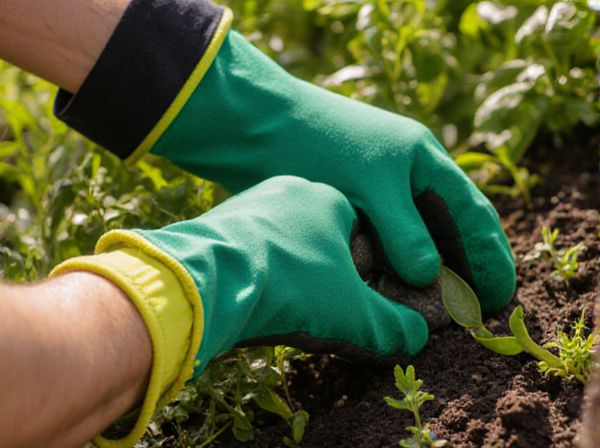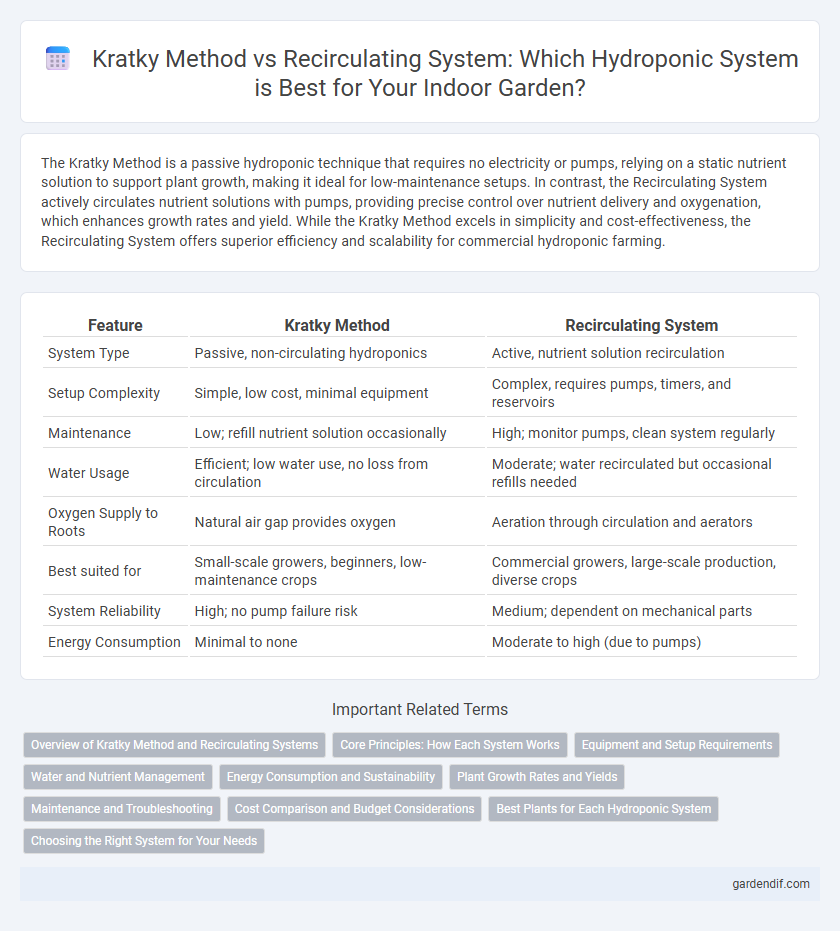
Kratky Method vs Recirculating System Illustration
The Kratky Method is a passive hydroponic technique that requires no electricity or pumps, relying on a static nutrient solution to support plant growth, making it ideal for low-maintenance setups. In contrast, the Recirculating System actively circulates nutrient solutions with pumps, providing precise control over nutrient delivery and oxygenation, which enhances growth rates and yield. While the Kratky Method excels in simplicity and cost-effectiveness, the Recirculating System offers superior efficiency and scalability for commercial hydroponic farming.
Table of Comparison
| Feature | Kratky Method | Recirculating System |
|---|---|---|
| System Type | Passive, non-circulating hydroponics | Active, nutrient solution recirculation |
| Setup Complexity | Simple, low cost, minimal equipment | Complex, requires pumps, timers, and reservoirs |
| Maintenance | Low; refill nutrient solution occasionally | High; monitor pumps, clean system regularly |
| Water Usage | Efficient; low water use, no loss from circulation | Moderate; water recirculated but occasional refills needed |
| Oxygen Supply to Roots | Natural air gap provides oxygen | Aeration through circulation and aerators |
| Best suited for | Small-scale growers, beginners, low-maintenance crops | Commercial growers, large-scale production, diverse crops |
| System Reliability | High; no pump failure risk | Medium; dependent on mechanical parts |
| Energy Consumption | Minimal to none | Moderate to high (due to pumps) |
Overview of Kratky Method and Recirculating Systems
The Kratky Method is a passive hydroponic technique that requires no pumps or electricity, relying on a static nutrient solution and air gap for root oxygenation, making it ideal for small-scale or low-maintenance setups. Recirculating hydroponic systems actively pump nutrient solutions through plant roots, offering precise control over nutrient delivery and oxygen levels, resulting in faster growth and higher yields. Both methods support soilless cultivation but differ significantly in complexity, cost, and scalability, with Kratky suited to beginners and recirculating systems preferred for commercial production.
Core Principles: How Each System Works
The Kratky Method operates on a passive hydroponic principle where plants grow in a nutrient solution without active water circulation, relying on oxygen exposure at the air gap for root respiration. In contrast, recirculating systems use pumps to continuously cycle nutrient-rich water, ensuring consistent oxygenation and nutrient delivery to the plant roots. This fundamental difference affects system complexity, oxygenation levels, and maintenance requirements in hydroponic cultivation.
Equipment and Setup Requirements
The Kratky Method requires minimal equipment, relying on a simple container, a nutrient solution, and net pots, making it ideal for low-maintenance hydroponic setups without pumps or aerators. In contrast, the recirculating system demands complex infrastructure including water pumps, tubing, reservoirs, and aeration devices to continuously circulate nutrient-rich water to the plants. This difference in setup complexity directly impacts initial investment, energy consumption, and maintenance efforts between the two hydroponic systems.
Water and Nutrient Management
The Kratky Method relies on a static water and nutrient solution, eliminating the need for pumps or circulation by allowing plants to consume resources gradually until depletion. In contrast, recirculating hydroponic systems continuously cycle water and nutrients, enabling precise control over oxygenation, pH, and nutrient concentration to optimize plant growth. While the Kratky Method offers simplicity and low maintenance, recirculating systems provide enhanced water and nutrient management through real-time monitoring and adjustment capabilities.
Energy Consumption and Sustainability
The Kratky method consumes virtually no energy as it relies on a passive nutrient solution without pumps or aeration, making it highly sustainable and ideal for low-resource environments. In contrast, recirculating hydroponic systems require continuous energy input to power water pumps, aerators, and sensors, resulting in higher operational costs and increased carbon footprint. Evaluating energy consumption reveals the Kratky method's significant advantages in sustainability, especially for small-scale or off-grid applications.
Plant Growth Rates and Yields
The Kratky method offers a passive hydroponic approach where plant growth rates are generally slower compared to recirculating systems due to limited nutrient availability and oxygenation. Recirculating systems provide continuous nutrient flow and oxygen exchange, resulting in faster growth rates and higher yields for leafy greens like lettuce and basil. Studies indicate that recirculating hydroponics can boost yields by up to 30% compared to Kratky setups, making them more efficient for commercial-scale production.
Maintenance and Troubleshooting
The Kratky method requires minimal maintenance due to its passive, non-circulating design, eliminating the need for pumps or timers, which reduces potential mechanical failures. In contrast, recirculating systems demand regular monitoring and maintenance of pumps, water flow, and nutrient levels to prevent clogs, pump failures, and system imbalances. Troubleshooting in Kratky setups centers mainly on nutrient solution depletion and root oxygenation, whereas recirculating systems involve diagnosing pump malfunctions, algae buildup, and nutrient film integrity.
Cost Comparison and Budget Considerations
The Kratky Method offers a significantly lower initial investment and reduced operational costs due to its passive, non-circulating design, eliminating the need for pumps or electricity. In contrast, recirculating systems demand higher upfront expenses for pumps, timers, and filtration equipment, alongside ongoing energy costs and maintenance. Budget-conscious growers often prefer the Kratky Method for small-scale or experimental setups, while recirculating systems suit larger operations with capacity to bear higher costs for enhanced control and crop yields.
Best Plants for Each Hydroponic System
Leafy greens such as lettuce, spinach, and kale thrive in the Kratky method due to its passive nutrient delivery and low maintenance requirements. In contrast, recirculating systems excel with fruiting plants like tomatoes, cucumbers, and peppers by providing continuous nutrient and oxygen flow that supports higher growth rates. Herbs including basil and mint also perform well in both systems, but benefit from the precise nutrient control in recirculating setups.
Choosing the Right System for Your Needs
The Kratky method offers a passive hydroponic solution ideal for small-scale or beginner growers seeking low-maintenance systems without pumps or electricity, while recirculating systems provide continuous nutrient flow suitable for commercial operations requiring precise control and scalability. Choosing between these depends on factors like budget, available space, desired crop yield, and technical expertise. For high-efficiency production with consistent nutrient delivery, recirculating systems excel, whereas the Kratky method suits those prioritizing simplicity and minimal intervention.
Kratky Method vs Recirculating System Infographic

 gardendif.com
gardendif.com